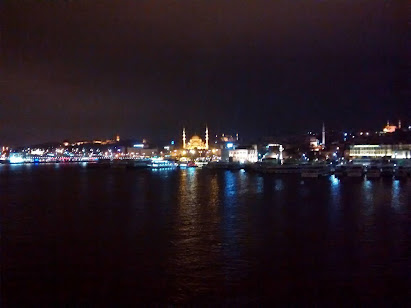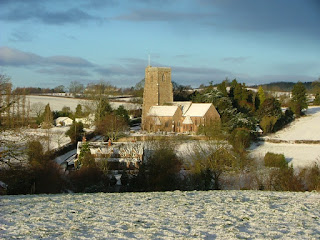Week 8 Home
Monday 1st March
Leaving Oviedo we head for the coast road and hop along the cliff tops from beach to sandy cove, through red rooved villages more affluent than we've seen inland. We're in Santander for coffee, picking a watering hole from among the serried ranks of 20th century hotels along the waterfront. Further along the coast the cathedral of Bilbao is dedicated to St John so we feel we have to call in there. It is cool and airy, less ornate than other Spanish churches we have visited; more reminiscent of British cathedrals, Salisbury perhaps, on the inside anyway. We stop to sample some Basque cuisine: bacalao pil pil, cod in garlic and olive oil, called pil pil for the sound the skin makes as it pops in the hot oil; alubias de Tolosa, baked beans more delicious by far than anything you'll find in a tin at Tesco.
We are back among rolling hills, leaving the industrial lowlands behind us and gradually the scenery become wilder and more mountainous. We drop back to the coast at Donostia San Sebastian and linger on the promenade to nibble at pinxtos and watch the Atlantic rollers breaking gently on the sheltered beach.
From here to the Basque-French frontier is not far and we are soon back among more familiar place names, although there is some amusing hybridisation along the way: the Rued de Notre Dames runs into the Chemin de Bixikennea. Even St Jean de Luz is a cocktail of a name. Biarritz is chic and elegant and we feel very scruffy but we're not the only ones to lower the tone, there are other hikers too.
Tuesday 2nd
Ruler straight, the coastline that runs between Biarritz and the estuary of the Gironde is edged with towering dunes and pale sand where the waves break with mesmeric ferocity. We spend the day alternating between the beach while the tide is out and the strand is firm, and the more sheltered coast road.
At Arcachon we could turn inland but instead we skirt the bay and keep going north, turning eastward only when we come in among the sunny slopes where some of the finest wines of France are grown along the banks of the Gironde. The vineyards are reverently tended in disciplined lines, oriented to catch the best the terrain has to offer, a rose planted at the end of every other line to attract pollinators. Paulliac, St Julien, the names conjure up ruby nectar of inestimable elegance and value. The lon g low buildings of Château Mouton Rothschild could just as easily house a string of thoroughbred racehorses. We are lucky to find a dégustation at one of the smaller vineyards where they are happy to show off their skills and sell us a bottle or two.We arrive at the city of Bordeaux quite late.
Wednesday 3rd
Crossing the vineyards and farmland around Cognac, wide open skies give us a fine view of scudding clouds, some of them shedding rain but, luckily, not on us. It is all very pleasant, easy walking but a little same-ish and dull after the drama of the Camino. Here and there we have to climb a hill but rather more there than here. Fortunately we are coming into Brit territory. Every now and then one or other of us pulls out a phone, muttering 'We have friends who live near here.' More often than not those friends come and join us for a few miles. Fond as we have all grown of one another, it is nice to see new faces and morale is boosted.
As we approach the Loire we have a look at the map to see if there is a château or two we might take a look at. Azay le Rideau is not too far (nor is Saumur but Azay is more romantic and we feel the need for a bit of romance). Built on an island in the Indre river it rises out of the stillness of the water, doubling in size thanks to its reflection. François 1er was the first of the Renaissance kings of France, one who valued culture and beauty not least because he could, since he had the luxury of comparative peace, at least on home territory. He did not have to build massive fortifications so much as an emblem of wealth to demonstrate his power with round turrets and steeply pitched slate rooves above windows designed to let in the light and the view rather than keep out an enemy.
We cross the Loire.
'Are you sure we want to cross? You know what it means, don't you?'
'?'
'Goodbye to warm weather. The Loire famously divides southern warmth from northern chill.'
We zip up our jackets and quicken our pace.
If you Google Le Mans, you get the motor race and 'was Ken Miles robbed of his win?' You don't immediately get any sense of the delightful medieval town with its narrow cobbled streets. It is the birthplace of the Plantagenets who gave us kings of England from 1216 to 1485. The walls of their palace were built on top of roman walls which still stand today, as strong as ever as we pass by. We wander the streets looking at menus outside the restaurants. No danger of going hungry tonight.
Thursday 4th
Our route today takes us between two national parks, Normandie-Maine and the Perche, where the Percheron heavy horses come from. Lanes and tracks criss-cross huge woodlands of slender trees where the light filters softly and the birds sing. Tall spires herald cosy, groomed villages nestle among orchards, the tricolore flies from the flagpole outside the Mairie. We discuss the ways in which it is reminiscent of England and yet completely different.
As the forest gives way to open farmland, place names catch our eye, some descriptive like Boischampré, others for their regional spellings: Montmerrei, Marcei.We come across a market where a farmer is selling crates of live ducklings. They are too sweet and the temptation is to smuggle some home. Fortunately common sense prevails.
Friends continue to join us or make arrangements to meet in Caen.
'Coucou, Isabelle! On est tout près de chez vous.'
'On se verra tout à l'heure!'We have lunch in Falaise. The town is dominated by the picture-book round tower which makes the keep, sturdy and square, look somehow incongruous. We make time to visit the château where William Duke of Normandy, 'the Conqueror', was born. Here he is on his horse in the square, surrounded by his forefathers.
'Fearsome bruisers.'
The castle has been restored without the sort of restriction English Heritage imposes, so modern concrete happily bolsters 12th century fortifications. Inside, video projections allow the stones to tell their story and the tablets we are given superimpose images of the interior as William would have seen it. Impressive.
WWII cannot be ignored between Falaise and the coast. There are almost no old buildings, everything was flattened in the long and brutal struggle that followed the Normandy landings. The Mémorial de Caen pays tribute to the tenacity of the armies, lest we forget.
Caen has another castle, a magnificent fortress built by William, but it is also a lovely town where we browse and shop, meet friends and enjoy our last meal on foreign soil.
From there to Ouistreham to find our overnight cabins on board Le Mont St Michel.
Goodbye Europe.
Friday 5th
We dock at 6.45am where Mr Costa provides early sustenance. After a fond farewell to Sarah, Ed and Grace, the rest of us are soon clear of the industrial areas, strolling towards Winchester along the Hampshire lanes where snowdrops are fading, aconites star the verges and daffodils are beginning to nod their heads. We pause for breakfast in lovely Winchester before heading across the Berkshire Downs.
'Goodbye the Wednesday Walkers, see you soon!' We wave Susie, Bridget and Ness off along the Ridgeway before dropping into the Savernake Forest and crossing the Kennet at Stitchcombe.
As you drive westward along the M4, approaching Swindon you come through a stretch of softly curving downland. This is where we find ourselves now. It is as lovely and inviting as it looks from the car.
Rather than walking along the A419 north of Swindon, as Google suggests, we turn off onto the evocatively named Tadpole Lane, which takes us a quieter way into Cricklade where we say hello to a very baby Thames and buy a OS maps. The network of footpaths, some better signposted than others, takes us meandering pleasantly through the Costswolds. We drop off the escarpment south of Birdlip, cross the Severn at Gloucester and in no time at all we are debating which of our favourite routes to take back from Newent. St Anne's Vineyard wins. We cross the M50 into Kempley Woods and here is Upton Bishop. David is waiting to greet us at the church along with quite a welcoming committee and a wonderful Upton Bishop spread of tea and cake. Michael, who flew home from Florence some days ago, interrogates us about our adventures. He hasn't read the blog, of course, he wants to hear it first hand.
'Well done everyone!' grins David, 'What a fantastic achievement and thank you all for your support and generosity. Don't forget that services start again on the 21st. We'll look forward to seeing you then at 10.30.'
'The theme will be Pilgrimage in your honour,' adds Michael.
Lisa, Lee, James and the Williamses still have some way to go so we cheer them on their way. Stopping feels very odd and we will probably all be restless for a few days as we settle back into the old routines.
Thank you for your company.
Keep walking.
See you soon.
'Bye.







Comments
Post a Comment